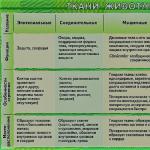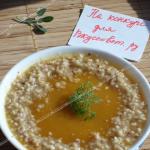The topic of the lesson is iotized vowels. Lesson summary "Iotated vowels"
Most letters of the Russian alphabet are signs of one sound. The letters E, I, E, Yu denote two sounds: a consonant J and a vowel, for example: J + E = E; J+A=I; Y + O = E; Y + Y = Y.
For the correct sound of these vowels, you need to know the position of the speech apparatus with the sound Y and each of the vowels E, A, O, U.
Sound Y. When pronouncing the sound Y, the tip of the tongue touches the lower teeth, and the back is strongly tense and raised towards the front of the hard palate, the vocal cords vibrate, and the soft palate is raised.
The Y sound is pronounced only with vowel sounds.
Try to pronounce vowels alternately in the following pairs: A-Z, O-Y; U-Yu; E-E, and you will feel how, when moving to iotized sounds, the back of the tongue tenses and rises to the front of the hard palate; the lips, lower jaw and tip of the tongue follow the same movements as when pronouncing A, O, U, E.
The position of the speech apparatus during the formation of consonant sounds.
Sounds B, P. The lips are tightly closed. The tongue lies freely, the tip is at the lower incisors; with the sounds P and B, the velum is raised; a stream of exhaled air directed into the mouth breaks the closed lips, causing the sounds B and P to be formed. With the sound B, the vocal cords vibrate.

Rice. 9. Articulation P, B: a - outside; b - inside.
Sounds V, F. The lower lip, with its inner edge, lightly touches the upper teeth, the palate is raised, the tongue lies freely - the tip is at the lower front teeth. The air blown between the teeth and lip forms the sounds B and F. With the sound B, the ligaments vibrate.


Rice. 10. Articulation F, V: a - outside; b - inside.
Sounds D, T, N. The tongue is slightly raised to the palate and its front part is pressed tightly against the upper front teeth. With the sound D and N, the ligaments vibrate; with the sound D and T, the velum palatine is raised; with the sound N the velum is lowered.


Rice. eleven. Articulation D, T, N: a - outside; b - inside.
Drooping palate with N.
Sounds K, G, X. With the sounds K and G, the strongly arched back of the tongue touches the hard palate. The velum is raised. An exhaled stream of air breaks between the back of the tongue and the palate, this produces the explosive sounds K and G, but if there is a gap between the palate and the back of the tongue, then a long sound X is produced. The velum of the palate is raised when the sounds K, G, X are formed. With the sound G, the vocal cords vibrate.


Rice. 12. Articulation K, G, X: a - outside; b - inside.
Sound R. The formation of the sounds P and P soft is caused by frequent vibrations of the tip of the tongue under the influence of an exhaled stream of air. With a hard sound P, vibration occurs at the alveoli of the upper front teeth. With soft P, the tip of the tongue fluctuates near the front upper teeth. The vocal cords vibrate.
 Rice. 13. A articulation of K in combination with different vowels
Rice. 13. A articulation of K in combination with different vowels
 Rice. 14. Articulation P (inside)
Rice. 14. Articulation P (inside)
Sound M. The lips are slightly closed, the tongue lies freely, as with the sound A; exhaled air passes through the nose.

Rice. 15. Articulation M Rice. 16. Articulation L
(outside) (outside)
Sound L. The tip of the tongue touches the upper front teeth, the root of the tongue is raised, the velum is raised, the vocal cords vibrate.
With the sound L soft, the tip of the tongue touches the upper alveoli, the entire tongue is more tense than with the sound L hard.
Sounds Z, S. The wide tip of the tongue touches the lower teeth and partly the lower gums, and the front part of the back of the tongue with a small longitudinal groove on it rises to the upper gums and forms a narrow gap with them. The lateral edges of the tongue are pressed tightly against the upper molars. The blown air passes along the groove of the tongue between the teeth and forms sounds 3 and C. The mouth is slightly open (by three millimeters), the palate is raised; When sounding, the 3rd vocal cords vibrate. With soft 3 and C, the middle part of the back of the tongue is closer to the hard palate; in the sound, this softness is expressed in a slight increase in tone.


Rice. 17. Articulation 3, C:
a - outside; b - inside
Sounds Zh, Sh. The wide tip of the tongue is raised to the upper alveoli, almost to the edge of the alveoli, but does not touch the hard palate. A gap forms between the tongue and the hard palate. The lateral edges of the tongue are pressed tightly against the upper molars. The back of the back of the tongue is also raised and forms a second narrowing with the hard palate. A depression is created in the tongue (it is otherwise called a “bucket” or “cup”). The teeth are slightly apart, the lips are slightly pushed forward. With the sound Z, the ligaments vibrate.


Rice. 18. Articulation W, F: a - outside; b - inside
CelAnd:to activate children's knowledge about iotized vowels and the letters that represent them; improve the ability to divide words into syllables; develop the ability to construct sentences from words.
During the classes
I. Updating of basic knowledge.
! The game “Who can collect it faster?”
On the desk Object pictures with one-, two- and three-syllable names of objects are displayed.
Children sitting on the first row select pictures with one-syllable names of objects, on the second row - with two-syllable names, on the third - with three-syllable names.
Whale, axe, bridge, pencil, bus, crayfish, saw, glass, pigeons, sparrow, tiger, horse, frame, balls, drum, owl, table, chickens, parrot, elephant, swallow, poppy, doll, plane, kettle, ruler, bow, house, spoon, magpie.
II. Vocabulary work.
1. R e dude - boys and girls at an early age.
& Etymology of the word.
Word Guys came from the word child. In old times child meant "small".
Write down this word, pronouncing it syllable by syllable, highlight the spelling, divide it into syllables, and add stress.
2. X O R O w ? - as it should be.
The rain fell and passed,
The sun in the whole world.
This is very good
For both adults and children.
V. Mayakovsky
& Etymology of the word.
The origin of the word is unclear. Perhaps in ancient times it meant “pure” or “brave.”
III. Formation of new knowledge.
1. Teacher's word.
The Russian language has an interesting consonant sound Y (iot). He loves to “play hide and seek” - “hide” behind other letters. Read the word.
At the end of this word there is a sound [y’] and a special letter for it - Y (I short). Now let's change the word:

The letter Y is no longer in these words, but the sound [y’] remains! Where is he hiding? And he hid behind the letters Ya, Yu, E, Yo, which denote two sounds at once:

2. Doing exercise 30.
How many syllables are in each word?
How many letters are in the first syllable of each word?
What letters are these?
What sounds do they represent?
In what cases are vowels e, e, yu, i consist of two sounds?
Vyvo d: iotated vowels e, e, yu, i consist of two sounds if they stand:
b at the beginning of a word;
b after vowels;
bafter b And ъ signs.
Sound-letter analysis of one of the recorded words:
Yula- yu - la
yu - [th’] - consonant, soft, sonorous.
[u] - vowel, unstressed.
l - [l] - consonant, voiced, hard.
a - [a] - vowel, stressed.
Why are there fewer letters than sounds?
Physical education minute
IV. Making up a story based on a picture.
1. Doing exercise 32.
2. Work on constructing sentences.
Doing exercise 33.
V. Lesson summary .
Which vowels are called iotized? List their.
Clap your hands when you hear a word that has more sounds than letters.
Skirt, fair, raccoon, chalk, iodine, spindle, apple, tree, sailor.
Homework: exercise 34.
Literacy lesson in 1st grade.
Subject: Writing words with iotated vowels at the beginning and in the middle of the word.
Commented reading of the text on questions.
Target: creating conditions for developing the skills of reading and writing words with iotated vowels at the beginning and in the middle of the word; as well as correct, syllabic, expressive, conscious reading.
Tasks: consolidate skillssyllabic analysis of words, drawing up sound patterns; learn to write words with iotated vowels at the beginning and in the middle of a word;
develop the skill of commented reading of text based on teacher questions; ability to work with text;
develop oral speech; fine motor skills of the hand and arms; phonemic hearing; speech; memory; attention; thinking; cognitive interest;
cultivate a caring attitude towards nature; sense of camaraderie and mutual assistance.
Results: students are able to write words with iotated vowels at the beginning and in the middle of the word; do syllabic analysis of words according to schemes; know how to read a text and understand its content; give comments on the text read, using literate speech; logically express their thoughts, reason, realize the importance of caring for nature; know how to show friendliness; show interest in the material being studied.
During the classes.
Organizing time. Psychological mood.
The cheerful bell rang
We are ready to start the lesson.
Let's listen and talk
And help each other.
Updating knowledge.
Today we had a guest come to our lesson. Guess who she is?
I am such a fashionista that everyone is surprised!
I love beads, sparkles - any decorations.
But to my great misfortune, believe me,
I only wear an outfit once a year.
(Christmas tree)
What kind of trouble happened to her?
Let's please our Christmas tree with our knowledge and good answers.
Repetition.
– Our Christmas tree is elegant.
What is it decorated with? (Letters - B, A, V, G, U, D, E, E, I, N, O, S, Y. Consonants on blue paper, vowels on red.)
What groups can they be divided into? (For vowels and consonants.)
I show the consonants and you pronounce their sounds.
Think about what groups vowel letters can be divided into? (On the softness and hardness of consonant sounds.)
Which letters can be distinguished from this group? (E and E)
Why?
State the topic and purpose of the lesson.
On the Christmas tree the words:
hedgehog Elena snow ice
Read the words.
What do these words have in common? (Letters E and E)
Who guessed what the topic of our lesson is?
Children independently formulate the topic of the lesson and tasks for support.
I will learn …..
I will find out......
I can ….
Work on the topic of the lesson.
Syllabic sound analysis of words – Elena:
Work in pairs with pencil cases; 2 students work at the board for testing.Self-test. Observing the position of the letter E in a word.
- What interesting things did you notice when drawing up the diagrams? (When we pronounce a letter at the beginning of a word, we hear two sounds - [Y"], [E]; when E comes after a consonant, we hear one sound [E])
Count the number of sounds according to the diagram. (6)
Now, in unison, we count the number of letters in a word. (5)
Compare the number of sounds and letters. Why?
Conclusion: When the letters –E and E are at the beginning of a word, they denote two sounds, so in such words there are more sounds than letters. When they come after a consonant, they represent 1 sound.
- Name the words in which the letters E and E represent 2 sounds. (Hedgehog …)
Name the words in which the letters E and E represent 1 sound. (Snow, ice, ...)
Fizminutka – for the development of fine motor skills of the hand.
Here are my helpers
Turn them any way you want
Once. two three four five
We begin to write.
Letter - work according to the copybook - page 6.
Hygienic skills when writing.
Preparing your hands for writing - drawing a pattern.
Letter uppercase and lowercase letters Her, Yoyo – line below the sentence.
(Analysis of the spelling of letters - E and E.)
E and Yo are sisters,
It's not easy to distinguish between sisters,
But the letter E has two dots,
Like nails in a ladder.
Why are E and Yo called sisters?
Do you want to know where Yo got two dots from?
Listen to the story about this.
One day the letter E ran into the forest. Suddenly a strong wind blew and the trees swayed. The letter E became scared and hid under a spruce tree. The spruce tree also swayed from the wind, and two cones fell on E, which caused two cones to form on E’s head. Because of this, it turned into another letter E, which turns out to be why E has two dots.
Teacher showing on the board, writing in the air.
Independent writing of letters.
Self-assessment:
Using a red pencil, highlight the most beautiful letter E and E that you have created.
Writing words from printed text with pronunciation - next line:
hedgehog Elena snow ice
Take a pencil, divide the words into syllables, put emphasis.
Feedback: The fan shows the number of syllables in words.
Conclusion: How to determine how many syllables a word has?
Yo – always shock.
Physical exercise.
Green Christmas trees
They sway in the wind,
Swaying in the wind
Bend low.
Lots of green Christmas trees
We'll do a lot of bending.
Vocabulary work:
Reading words - 1 student, in chorus, with emphasis.
WALKED APPROACHED
CAME
Explain the meaning of these words. (Demonstration - the student demonstrates the actions.)
NOS
TAKEN AWAY
Marina Vladimirovna Chekanova
Summary of the speech therapy lesson “Iotated vowels”
Chekanova M.V., teacher – speech therapist
Nefteyugansk
Preparatory group
Subject: « Yotated vowels»
Target: systematize children’s knowledge about iotated vowels EYYUYA at the beginning of a word in a strong position.
Tasks:
Educational:
The ability to identify sounds at the beginning of a word in a strong position, denoting a combination of sounds letters.
Correctional and developmental:
Develop phonemic awareness through differentiation iotated vowels;
Develop the articulatory apparatus and fine motor skills of the fingers with the help of gymnastics with bioenergoplasty.
Educational:
Develop the ability to answer fully, listen to the answers of your comrades.
Methods:
Verbal – conversation, explanation.
Visual – multimedia presentation, sound stones, syllables, elements letters, house models with letters E,Yo,Yu,I
Practical - performing articulations. exercises, tasks to determine the sequence of sounds, syllables; construction letters.
Technologies:
Health-saving (articulation, breathing exercises, physical exercises)
Computer techologies (slide presentation)
Gaming (didactic games, verbal)
Progress of direct educational activities
Introductory part.
Guests have come to us, let's say hello to them.
How else can you say hello?
Good afternoon, hello, hello, nice to meet you
And yogis, for example, say hello in this position. (slide)
Who are yogis?
Let's work like yogis, only not with our feet, but with our hands and our tongues.
Articulation gymnastics
Main part.
1. Write a sentence about yogas. (SCHEME)
What does the proposal consist of? (The sentence consists of words)
How are words separated from each other? (Pauses. How many pauses, so many words)
2. Name a word that has the sound Y.
Name the first sound in the word YOGI.
Let's remember what he is like.
How vowels sounds different from consonant sounds?
Physical exercise.
Divide into two teams: Command I-short, command vowels.
In front of you are two trees - with red apples (articulation models vowels) and with green ones. Whose team will pick the apples faster?
The teams stand opposite each other, holding in their hands "sounds-apples"
Will we be able to combine I - a short sound with vowels? (children's answers)
Let's find out
Look at the screen. Name the first sound in the word APPLES, the second.
Sounds of YA.
Come out those guys who have these in their hands "sounds - apples".
Same with others iotized letters
HEDGEHOG, YO sound.
Skirt, sound YU.
Spruce, sound YE.
Conclusion: Has the i-short teamed up with vowels sounds at the beginning of a word?
What happens when we pronounce two sounds? (At first there is a slight obstacle, a stutter, and then the sound continues)
A game "Stutters"
In what cases did we hear 2 sounds in words?
3. Game “Let’s bring sounds into the house”.
Each house has its own name.
What sounds will we introduce into the house with letter I? (YA, Yo (YO, Yu (YU)
Conclusion: With which letters"friends" YA sounds (With letter I)
4. Game "Say the words"
Name words that begin with the sounds YA (apple, yacht, Yana, Yasha)
YO (hedgehog, hedgehog, tree, ruff)
JE (spruce, raccoon, food, Emelya)
YU (Julia, Yula, Yura, humor, young)
Final part.
Which letters are indicated by two sounds at the beginning of a word? (E,Y,Y,Y)
Publications on the topic:
Summary of a lesson on teaching reading and speech development to preschool children “Vowels and consonants” Topic: "Vowels and consonants." Word game. Fairy tale "Kuroch-ka-Ryaba". goal: consolidation of knowledge about the sounds of vowels and consonants, memorization.






